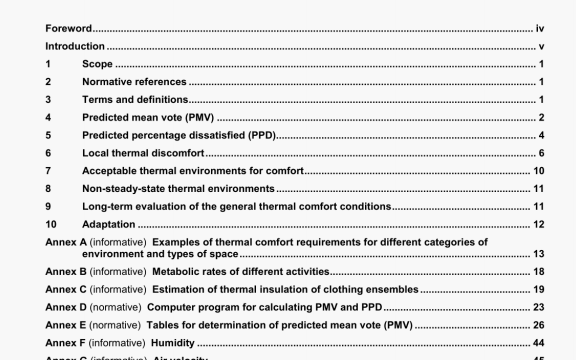ISO 7730 pdf download – Ergonomics of the thermal environment – Analytical determinationand interpretation of thermal comfortusing calculation of the PMV and PPDindices and local thermal comfort criteria.
The operative temperature at all locations within the occupied zone of a space should at all tines be within the permissible range. This means that the permissible range should cover both spatial and temporal variations, Including fbjctuations caused by the control system.
Figure A.1 applies for a relative humidity of 50 %: however, in moderate environments the air humidity has only a modest impact on the thermal sensation. Typically, a 10 % higher relative humidity and a 0,3 °C higher operative temperature are perceived as being warmer in equal measure.
The PUs in Table A.1 are not additive. In practice, a higher or lower number of dissatisfied persons may be found when using subjective questionnaires In field investigations (see ISO 10551).
The air velocity In the wace Is assumed to be <0,1 mIs. The relative air velocity, ij, caused by body movement is estimated to be zero f a metabdic rate, SI. less than 1 met and = 0.3 (.41 — 1) f .41> 1 met. The diagrams are determined for a relative humidity = 50 %, but the humidity only has a slight influence on the optimum and permissible temperature ranges
A.3 Local thermal discomfort
Figure A.2 give ranges for local thermal discomfort parameters for the three categories presented in Table A. 1.
The max. allowable mean air velocity is a function of local at temperature and turbulence intensity. The turbulence intensity may vary between 30 % and 60 % In spaces with mixed-flow air distribution. In spaces with displacement ventilation or without mechanical ventilation, the turbulence intensity may be lower.
The air velocity in a space influences the convective heat exchange between a person and the environment.This influences the general thermal comfort of the body(heat loss) expressed by the PMv-PPD index (seeClauses 4 and 5) and the local thermal discomfort due to diraught (Clause 6). There is no minimum air velocitythat is necessary for thermal comfort.However,increased air velocity can be used to offset the warmthsensation caused by increased temperature.
Often, the air velocity is increased by opening of windows or use of fans to adapt to warmer environments.Under summer conditions, the temperature can be increased above the level allowed for comfort if a means isprovided to also elevate the air velocity. The amount by which the temperature may be increased is shown inFigure G.1.The combinations of air velocity and temperature defined by the lines in this figure result in the sametotal heat transfer from the skin. The reference point for these curves is 26 C and 0,20 m’s of air velocity.Thebenefits that can be gained by increasing air velocity depend on clothing, activity, and the difference betweenthe surface temperature of the clothing/skin and the air temperature. Figure G.1 shows the air velocity that isrequired for typical summer clothing (0,.5 clo) and sedentary activities (1,2 met) that correspond to summercomfort.
Figure G.1 applies to an increase of temperature above 26 ‘C with both t, and t, increasing equally. When themean radiant temperature is low and the air temperature is high,elevated air velocity is less effective atincreasing heat loss. Conversely, elevated air velocity is more effective at increasing heat loss when the meanradiant temperature is high and the air temperature is low. Thus, the curve in Figure G.1 that corresponds tothe relative difference between air temperature and mean radiant temperature must be used.Large individualdifferences exist between people with regard to the preferred air velocity. Therefore, the elevated air velocitymust be under the direct control of the affected occupants and adjustable in steps no greater than 0,15 m/s.
In order to evaluate the comfort conditions over time (season,year), a summation of parameters must bemade based on data measured in real buildings or dynamic computer simulations.This annex lists fivemethods, each of which can be used for that purpose.
a)Method A
Calculate the number or percentage of hours during the hours the building is occupied, the PMV or theoperative temperature is outside a specified range.
b)Method B
The time during which the actual operative temperature exceeds the specified range during the occupiedhours is weighted with a factor which is a function of how many degrees the range has been exceeded.
ISO 7730 pdf download – Ergonomics of the thermal environment – Analytical determinationand interpretation of thermal comfortusing calculation of the PMV and PPDindices and local thermal comfort criteria
